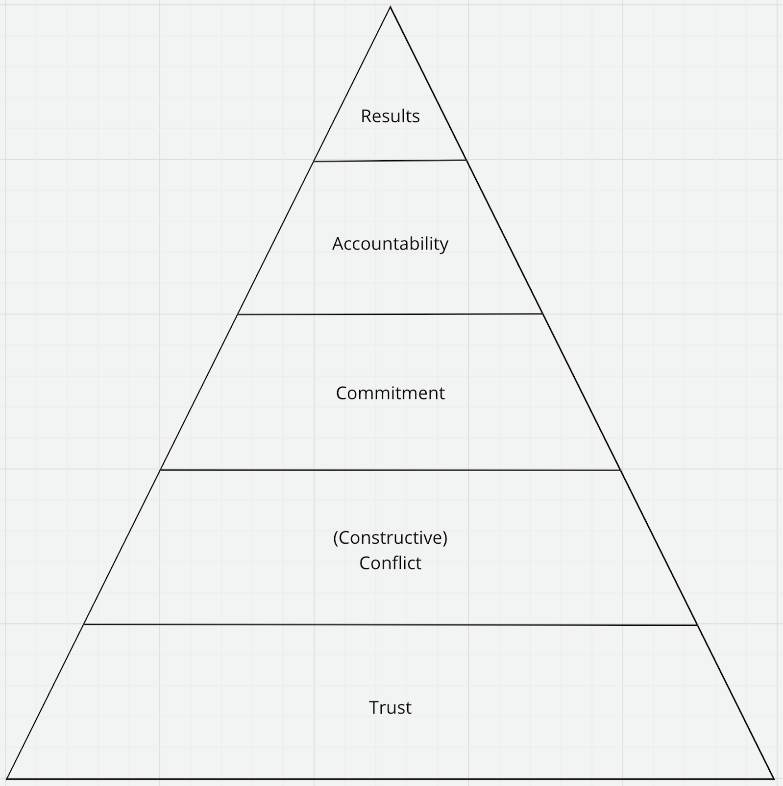In my day-to-day work as a Scrum Master, I work with many different teams across multiple layers of the company. When a management team approached me with the question of why their teams were never able to finish the work they committed to on time, it only took me one question for me to realize the issue: the team didn’t trust their management. I asked the management team, “What happens when the team tells you ‘no’?” and their response was “They never tell us no”. At that moment, I knew it was time to introduce the pyramid of Lencioni.
The Pyramid of Lencioni is a great model to determine how mature the collaboration within a group of people is. The model works as follows: just like a pyramid, the higher layers cannot exist if the lower layers aren’t solid. This concept is often referred to as “The Five Dysfunctions of a Team”:

| Top of the pyramid – (Lack of) | Results |
| (Avoidance of) | Accountability |
| (Lack of) | Commitment |
| (Fear of) | Conflict |
| Base of the pyramid – (Absence of) | Trust |
Let’s do a quick explainer of the model starting at the bottom of the pyramid.
Trust at the base of it all
Even if we ignore the rest of the pyramid, it becomes clear that for a team to function well, the individual members must trust each other. This includes trusting each other’s work, trusting that when someone else picks up a story, they’re able to deliver it or ask for help when they get stuck, and trusting that personal disclosures will not be used against them. While it’s not impossible to collaborate on a shared outcome without trust, there can be no teamwork and, as a result, no team.
Trust as a requirement for constructive Conflict
For example, imagine someone suggests doing something that you don’t agree with, but you’re afraid that if you voice your disagreement, they’ll get angry, shout at you, twist your words, or complain to management. Will the two of you have a constructive conflict and reach the best outcome for your team and company? This is an extreme example but in day-to-day situations, a lack of trust can lead to nuanced avoidance of conflict. To engage in a constructive discussions, you both need to trust each other, trust that you’re both capable, and trust that you both have team’s and company’s best interests in mind.
Constructive Conflict as a requirement for Commitment
If we take the lack of commitment from the beginning of this blog, this model explains that positive and constructive conflict is a requirement for a team to make a commitment. How can you truly commit to something if you aren’t able to speak up about the parts you don’t agree with? If a Product Owner pushes for more than you think you can handle but you don’t speak up because you don’t think they’ll trust your judgment, the discussion and therefore constructive conflict is lost. How can you ever be committed to the Sprint Goal if you didn’t agree with the scope from the beginning? You’ll probably just do what you can and consider that enough, but you won’t be invested in the outcome because you felt from the beginning that it was impossible.
Results & Accountability
Once those basics of teamwork are established- trust in yourself and your team, the ability to have constructive conflict and shared commitment. Then you can also have accountability where you hold yourself and your team members accountable for the commitments you’ve made. Rather than dodging questions or accepting less from specific team members, everyone can start firing on all cylinders and delivering their best work. That’s when you get extraordinary, team based and most importantly, recurring great results.
With this pyramid in mind, it becomes clear why it’s so difficult for a team to commit to a goal when team members leave, or new people join. They have to restart building trust based on the new situation. If your team consistently doesn’t make their commitments, start by determining if there is a healthy amount of constructive conflict where everyone is involved. If not, it’s time to further develop the trust in the team and in their environment. Only once that trust is established can you build your pyramid from there.
I’d like to end this blog with a challenge: take a moment to look at the pyramid and determine where your current team is at. Perhaps even discuss it with the other team members and you’ll see that outcomes may vary and that the base of your pyramid is more wobbly than you thought!

 English | EN
English | EN 